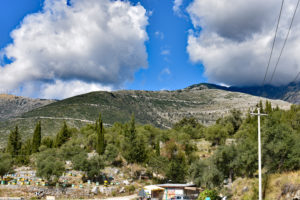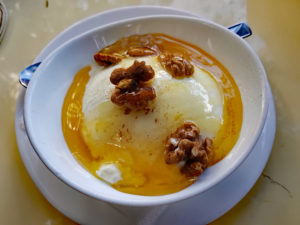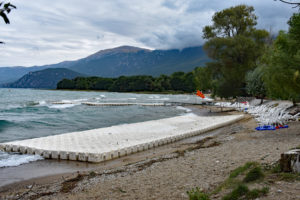On route from Saranda to Vlora, a journey of 121 km, we stopped frequently.
Firstly, near the town of Himare, was the early 19th century Porto Palermo Castle, built by Ali Pasha Tepelena, in the Bay of Palermo. This used to be one of the main harbours of the ancient world and was known as Panorama Bay. The castle was built with the help of French military engineers who were said to have been killed by the Pasha after its construction.
Having parked, we walked down a few steps, past graffiti covered buildings, onto the shoreline. It was rundown, with dilapidated sun loungers and parasols onshore, and rusty old boats moored offshore. The only point of interest was a small, closed Serbian Orthodox church built for one of Ali Pasha’s wives who was a Christian. During and after World War 2, the castle was used as a prison and shelter for military units.
A stone causeway, or a rocky path, depending on your viewpoint, followed by an uphill track led to the fortress where we paid 100 lek/75p each. The castle was triangular in shape with a five-sided tower on each corner. Inside the 6ft thick walls, were a series of rooms leading off a central one, mostly with low arches. In the prison, we needed torches as it was very dark.
A very steep flight of stone steps led up to the battlements on the rooftop, where we had spectacular views of the Albanian coast, and that of neighbouring Greece. We could just see what is known as the “James Bond Cave” through binoculars.
Back in the car, we continued our drive around the bay, and stopped nearer the 007 Cave: a huge tunnel blasted into the cliffs. It was built as a shelter for submarines which the Soviet Union based in the Adriatic from the late 1950s. When Albania fell out with Russia and became friends with China, the submarines were left behind. As this was a huge military area during the communist era, there were the remains of buildings and a line of bunkers.
As we continued northwards up the Albanian Riviera, we had dramatic mountains on one side and the deep blue Adriatic Sea on our left. The road snaked through the pretty villages of Vunoi and Dhërmiu where we stopped briefly for photographs. In both, the white houses with their wooden doors and shutters were all the same and made a spectacular sight as they spilled up the hillside. Two artists had set up easels and were painting a roadside church.
During our time in Albania, we’d seen lots of beehives and we stopped in Palasa, with its row of colourful hives and roadside stalls selling jars of honey.
The most spectacular part of the journey was going over the Llogoraja Pass at 1,000m above sea level. The narrow road zig-zagged up the mountain in astonishing fashion and our driver joked that the architect of the road was a donkey. A stop at a viewpoint provided panoramic views. At lunchtime, we entered the Llogoraja National Park where we started downhill. We stopped at the Alpin Hotel, opposite the closed Visitors’ Centre, where our driver treated us to a local speciality, natural yoghurt with honey and walnut halves.
We continued down to the coast, stopping for photographs of Orikumi, a large military base, and the Bay of Vlora, before arriving in Vlora itself where we stayed for three nights. It had been a wonderful and varied journey.










